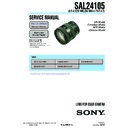Sony SAL24105 Service Manual ▷ View online
4-18
SAL24105 (3.5-4.5/24-105) (24-105mm F3.5-4.5)
4-3.
PROJECTIVE RESOLVING POWER CHECK/ADJUSTMENT
4-3-1. Projective Resolving Power Adjustment
Equipment
• Lens Test Projector and Variable Transformer (Output voltage: AC 100 V)
Note:
Connect the variable transformer (Output voltage: AC 100 V) to the lens test projector.
• A-mount Attachment
• Screen (Art paper)
• Tape Measure
• Plane Mirror (For SLRs)
1. Preparations
Note:
Note:
Check the projective resolving power of the checking lens at the following focal-length and distance.
Focal-length f (mm)
distance (m)
24
1.1
50
2.0
105
4.0
Table 4-3-1
1)
Perform the following steps (1) to (3), and incorporate the internal lenses of the lens test projector according to the checking focal-
length.
(1) Open the lid of the lens test projector.
(2) Pull up and turn the fixed levers on the right and left sides of the lens test projector.
(3) Remove or insert the lens.
Note:
Be sure to have the right position and direction of the lens.
Fig.4-3-1
Lens test projector
Incorporate of the lenses
according to the checking focal-length (f).
according to the checking focal-length (f).
Lens
Fixed lever
Fixed lever
Lid
f=18 to 35 mm
f=35 to 100 mm
f=100 to 200 mm
f=200 to 300 mm
Heat-absorbing filter
Chart
Chart
Chart
Chart
Filament
Filament
Filament
Filament
4-19
SAL24105 (3.5-4.5/24-105) (24-105mm F3.5-4.5)
2)
Attach the checking lens to the lens test projector, and set the equipments as shown in Fig.4-3-2.
3)
Turn the fan switch of the lens test projector to ON, then turn the lamp switch to ON.
Fig.4-3-2
4)
Turn the focus ring of the checking lens until the chart image projected on the screen is the sharpest at the center (y’=0).
5)
Set the plane mirror to the center of the projected image (y’= 0), and adjust the projector position so that the mirror reflects the light
to the center of the lens.
Distance
Lens test projector
Chart
Fan switch
Lamp switch
Plane mirror
Screen
A-mount attachment
Checking lens
F
L
4-20
SAL24105 (3.5-4.5/24-105) (24-105mm F3.5-4.5)
2. Checking Method
1)
Turn the focus ring of the checking lens until the chart image projected on the screen is the sharpest at the center (y’=0).
2)
Read the number of the smallest pitched lines at the center (y’= 0).
Fig.4-3-3
3)
Turn the mount rotation ring of lens test projector until the projected image at a certain peripheral point (y’= 15 or 18) on the screen
appears the most unsharp.
Read the number of the smallest pitched lines (both saggital and meridional: 3 lines) at the peripheral point.
Note:
When reading the number of the smallest pitched lines, be careful of the spurious resolution.
Spurious resolution is the reversed image of 2 or 4 lines which appears on screen when focus is beyond maximum revolving
power.
Do not confuse spurious resolution for the smallest pitched lines.
Fig.4-3-4
4)
Change the focal-length (zoom) and distance of the checking lens, and check that the all readings (y’= 0, y’= 12 (f=24, meridional
(M) only) saggital (S) and meridional (M) at y’= 15 or 18) at each focal-length (zoom) and distance is within the specification of the
Table 4-3-2.
Specification
Focal-length distance (m)
Number of the smallest pitched lines
f (mm)
Center (y’=0)
y’= 12 (Lines per mm)
y’= 15 (Lines per mm)
y’= 18 (Lines per mm)
(Lines per mm)
S
M
S
M
S
M
24
1.1
125 or greater
—
25 or greater 40 or greater 32 or greater 25 or greater 25 or greater
50
2.0
125 or greater
—
—
40 or greater 32 or greater 40 or greater 25 or greater
105
4.0
125 or greater
—
—
40 or greater 25 or greater 40 or greater 25 or greater
Table 4-3-2
The number represents for lines per mm.
Saggital (S)
Meridional (M)
Correct resolution
Spurious resolution
Ver 1.3 2007.07
4-21
SAL24105 (3.5-4.5/24-105) (24-105mm F3.5-4.5)
4-3-2. Projective Resolving Power Check
Note:
• Check the projective resolving power. If it does not meet the specification, adjust the projective resolving power.
• The following projective resolving power adjustments 1 and 2 meet the specifications respectively.
1. Projective Resolving Power (Warp) Adjustment
Check the projective resolving power. Confirm whether the focused point should locate in front or at back of the focused peripheral
points, and adjust.
1)
Set the focal length of lens to 105 mm and adjust the focus so that the peripheral “y’= 18” reaches the maximum resolution.
2)
Check the resolution of center “y’= 0”. (Check whether it locates in front or back of the projected plane.)
3)
According to the position of maximum resolution of center “y’= 0”, increase or decrease the thickness of washer to adjust the interval
between 3rd group and 4th group by the amount calculated by the formula below.
(1) If the position of maximum resolution of center “y’= 0” locates in front, decrease the thickness of spacer adjustment washer.
(2) If the position of maximum resolution of center “y’= 0” locates at back, increase the thickness of spacer adjustment washer.
Amount of thickness of adjustment washer for adjusting the space between 3rd and 4th groups = Distance (cm) measured in step 2)
/0.002
4)
If the projective resolving power does not meet the specification, adjust again.
2. Projective Resolving Power (Partial Blur) Adjustment
Check the projective resolving power. Conform the following adjustment if necessary.
1)
Set the focal length of lens to 105 mm and adjust the focus so that the center “y’= 0” reaches the maximum resolution.
2)
Check projective resolving power at reach peripheral point of “y’= 18”.
If the projective resolving power does not meet the specification, replace the 4 group lens block.
Click on the first or last page to see other SAL24105 service manuals if exist.

